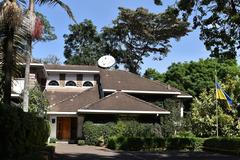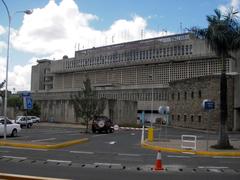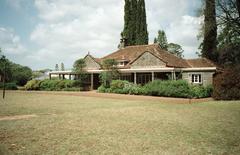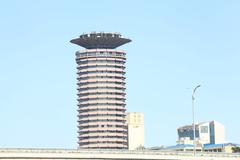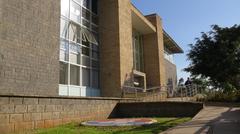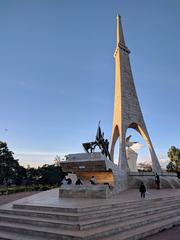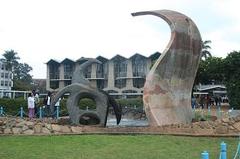Kenya National Archives Nairobi: Visiting Hours, Tickets, and Historical Sites Guide
Date: 04/07/2025
Introduction
Located in the heart of Nairobi’s bustling central business district, the Kenya National Archives stands as a testament to the nation’s rich history and cultural heritage. Housed in a landmark building originally constructed in the 1930s as the National Bank of India, the Archives seamlessly blend colonial architecture with modern preservation, symbolizing Kenya’s journey from colonial rule to independence and beyond. The institution is renowned not only for safeguarding government records, photographs, maps, and artifacts but also for offering visitors an immersive experience into Kenya’s diverse past. Whether you are a history enthusiast, researcher, student, or a curious traveler, the Kenya National Archives is a must-visit destination in Nairobi.
For official information, refer to the Kenya National Archives Official Website, or consult curated travel resources like Twende Sasa and Tripventure.
Table of Contents
- Introduction
- Historical Background and Evolution
- Visiting Information
- Architectural and Cultural Highlights
- Collections and Exhibits
- Nearby Attractions
- Digital Access and Preservation
- FAQ
- Conclusion & Call to Action
- Official Resources and References
Historical Background and Evolution
Origins and Early Development
The Kenya National Archives and Documentation Service (KNADS) was formally established under the National Archives Act of 1965, in response to the urgent need to safeguard Kenya’s historical records. Prior to this, important government documents were kept in less secure locations, risking deterioration and loss. The Archives building, with its colonial-era roots, is itself a part of Kenya’s layered history, having evolved from financial institution to national treasure house.
Mandate and Growth
KNADS is mandated to collect, preserve, and provide access to government records, photographs, maps, and artifacts chronicling Kenya’s social, political, and economic development. Over the decades, the Archives have grown to house approximately 40,000 volumes, making it one of East Africa’s leading historical repositories. In 1990, its scope expanded to include the National Documentation and Information Retrieval Service, managing government publications and enhancing its role in information preservation (KNADS Overview).
Visiting Information
Location and Directions
The Kenya National Archives is centrally located on Moi Avenue, opposite the Hilton Hotel and adjacent to the Ambassadeur Hotel, making it easily accessible by foot, taxi, or public transport from all parts of Nairobi. Matatus (minibuses), city buses, and ride-hailing services like Uber and Bolt operate in the area.
Address: Moi Avenue, Nairobi, Kenya
Hours and Admission
- Monday to Friday: 8:30 AM – 4:30 PM
- Saturday: 9:00 AM – 1:00 PM
- Sundays & Public Holidays: Closed
Entry Fees (2025):
- Kenyan Citizens: KES 50–100
- Residents: KES 200–300
- Non-Residents (Tourists): KES 500–600
Fees support preservation and maintenance. Additional charges may apply for guided tours or specialized research facilities (Twende Sasa).
Accessibility
The Archives are wheelchair accessible, with ramps and elevators to all public floors. Some older sections may have limited access; visitors with specific needs should contact the Archives in advance.
Guided Tours and Educational Programs
Guided tours are available for an additional fee and can be arranged in advance or upon arrival, subject to availability. Knowledgeable guides provide deeper context to the collections. Regular educational workshops and temporary exhibitions highlight themes such as indigenous cultures, national milestones, and historical figures (Tripventure).
Visitor Tips
- Visit early on weekdays to avoid crowds.
- Modest, comfortable dress is recommended.
- Security checks are conducted at the entrance.
- Photography is permitted in exhibition areas, but flash and videography may be restricted; always check with staff beforehand.
- Restrooms and a small gift shop are available on-site.
- No café is available inside, but many eateries are nearby.
- Keep personal belongings secure as Nairobi’s city center can be busy.
Architectural and Cultural Highlights
The Murumbi Gallery: A Pan-African Treasure
A highlight of the Archives is the Murumbi Gallery, located on the ground floor. Named after Joseph Murumbi, Kenya’s second vice-president and a passionate collector of African art, the gallery houses the largest Pan-African art collection on the continent. Here, visitors can view traditional implements, weaponry, textiles, musical instruments, and artworks from across Africa, including rare pieces dating to the 19th century (Twende Sasa).
The building itself is a Nairobi landmark, blending colonial and modern architectural elements, with climate-controlled spaces and fireproof vaults to ensure the preservation of invaluable documents.
Collections and Exhibits
Archival Holdings
- Government Records: Includes official correspondence, policy documents, and administrative reports from various ministries and parastatals.
- Personal Papers: Manuscripts, letters, and memorabilia from historical figures like Jomo Kenyatta and Joseph Murumbi.
- Photographic Archives: Black-and-white portraits and historical photos depicting Kenya’s leaders, independence movement, and societal changes.
- Maps and Drawings: Historic maps, architectural plans, and urban development documents.
- Artifacts: Ethnographic items such as tribal weapons, jewelry, and ceremonial objects.
- Murumbi African Heritage Collection: Traditional clothing, jewelry, calabashes, and unique dioramas of pre-colonial life.
Exhibitions
- Permanent Exhibitions: The Murumbi Collection and the Portrait Gallery, which features images of paramount chiefs, freedom fighters, and political leaders.
- Temporary Exhibitions: Thematic displays on independence, women’s history, and Nairobi’s growth; opportunities for public participation and artifact donations.
Nearby Attractions
Complement your visit to the Archives with other Nairobi historical sites:
- Nairobi National Museum
- Kenyatta International Conference Centre (KICC)
- Nairobi Railway Museum
- Maasai Market
- Karen Blixen Museum
Many visitors pair their trip to the Archives with a walking tour of Nairobi’s city center (WorldXplorr).
Digital Access and Preservation
KNADS is actively digitizing and microfilming fragile materials, enhancing both preservation and public access. While some documents are subject to a 30-year embargo for sensitivity, many become available for research and public viewing each year. Portions of the digital collection can be accessed online and through international collaborations (Cambridge History in Africa).
Frequently Asked Questions (FAQ)
Q: What are the Kenya National Archives’ visiting hours?
A: Monday–Friday: 8:30 AM–4:30 PM; Saturday: 9:00 AM–1:00 PM; closed on Sundays and public holidays.
Q: How much do tickets cost?
A: KES 50–100 for Kenyan citizens, KES 200–300 for residents, KES 500–600 for non-resident tourists.
Q: Are guided tours available?
A: Yes, for an additional fee. Book in advance or on arrival, subject to availability.
Q: Is the building accessible for visitors with disabilities?
A: Yes, there are ramps and elevators to most public areas.
Q: Can I take photographs inside?
A: Photography is generally allowed in exhibition areas but check for specific restrictions.
Q: How do I get there?
A: Located on Moi Avenue in Nairobi’s CBD, accessible by foot, public transport, or taxi.
Conclusion & Call to Action
The Kenya National Archives is more than a repository of historical documents—it is a vibrant cultural destination that offers profound insights into Kenya’s past and present. Its strategic location, rich collections, and affordable access make it welcoming to all visitors, from seasoned researchers to families and tourists. As Kenya advances its digitization and preservation efforts, the Archives continue to play a pivotal role in fostering national identity and pride.
Plan your visit today to immerse yourself in the treasures of Kenya’s history. For more travel tips and cultural guides, download the Audiala app and follow official social media channels for updates on special exhibitions and events.
Official Resources and References
- Kenya National Archives Official Website
- Twende Sasa: Kenya National Archives Entrance Fees
- Tripventure: National Archives Nairobi Attractions
- KNADS Overview
- Cambridge History in Africa
- Academia.edu: Role of Archives
- Wanderlog Guide
- Switch TV Feature
- TripHobo: National Archives
- WorldXplorr: Top Things to Do in Nairobi
